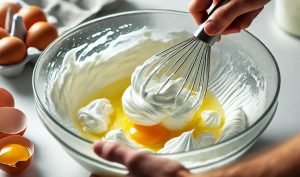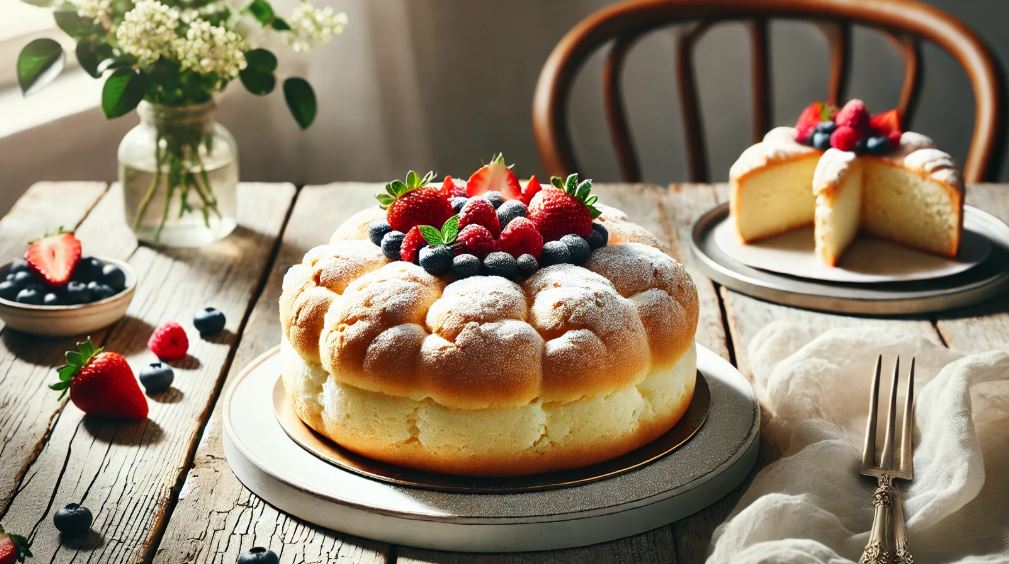Cloud cake is a delicately airy dessert that offers a unique alternative to traditional sponge or butter cakes. Known for its pillowy texture and minimal ingredients, it has quickly become a favourite among home bakers and professionals alike.
This guide breaks down everything needed to create the perfect cloud cake, from ingredient specifications to expert techniques.
Whether you’re exploring flourless options or rich chocolate versions, this step-by-step recipe ensures a reliable and delicious result every time.
What is Cloud Cake Recipe?
A cloud cake is a light, airy dessert known for its soft, melt-in-the-mouth texture, often described as a cross between a soufflé and a sponge cake.
It typically uses whipped egg whites to achieve its signature fluffiness, resulting in a delicately risen bake that’s as pleasing to the eye as it is to the palate.
Unlike traditional cakes that rely heavily on flour and butter, cloud cakes often minimise or eliminate these ingredients altogether.
This gives the cake a pillowy texture and a naturally gluten-free quality in many versions. The core idea behind cloud cake is to embrace minimalism, fewer ingredients, simpler steps, but a surprisingly delightful outcome.
Its popularity has surged in recent years due to its versatility. You can find versions like honey cloud cake, chocolate cloud cake, and Greek yoghurt cloud cake, each offering a unique flavour profile while retaining the signature texture. The cake is often served with minimal garnishes, like icing sugar, berries, or whipped cream.
It’s especially loved for being an elegant dessert choice without being overly rich. Cloud cake is perfect for those who enjoy subtle sweetness and want a bake that’s both impressive and easy to digest.
Why is Cloud Cake So Light and Airy?
The secret to the cloud cake’s ethereal texture lies in its key technique, incorporating air into the batter. This is most commonly achieved by whipping egg whites to soft or stiff peaks and then folding them gently into the rest of the mixture.
The trapped air creates volume, leading to a sponge that rises gently in the oven and collapses slightly on cooling to form a cracked, cloud-like top.
Several scientific principles contribute to the cake’s texture:
- Whipping egg whites: This creates a foam structure, trapping air.
- Low or no flour content: Reduces denseness, making the cake lighter.
- Minimal fat: Unlike butter cakes, cloud cakes use little to no fat, making the crumb airy.
Recipes like Nigella’s chocolate cloud cake and Waitrose’s flourless versions demonstrate how the absence of flour can enhance lightness, particularly when combined with whipped egg whites.
The cake’s collapse after baking is not a flaw; instead, it’s what creates its signature cracked top and mousse-like centre.
Additionally, baking at the correct temperature and using a gentle folding motion when combining the whipped whites helps retain the air bubbles. This results in a cake that feels soft, moist, and delicate, much like a bite of cloud.
What Ingredients Are Needed for the Perfect Cloud Cake?
While variations exist, most cloud cakes share a common foundation of a few simple ingredients.
Here’s a breakdown of standard ingredients used across popular recipes, including chocolate, honey, and Greek yoghurt cloud cakes:
| Ingredient | Quantity (approximate) | Notes |
| Eggs (large) | 4–6 | Whites separated from yolks |
| Sugar (caster/granulated) | 100–150g | Adjust based on taste and sweetness of variations |
| Greek yoghurt | 150g (optional) | Used in some lighter versions |
| Dark chocolate | 200g (optional) | For chocolate cloud cakes |
| Honey | 2 tbsp (optional) | Used in 2-ingredient honey cloud cake |
| Lemon zest/vanilla | 1 tsp | Adds fragrance and complexity |
| Cream of tartar | 1/2 tsp | Stabilises egg whites |
| Cornflour | 1 tbsp (optional) | Adds slight structure in flourless recipes |
Some recipes, like those from Kirbie Cravings or Truffle & Egg, eliminate flour entirely and rely on eggs and yoghurt for body.
Others, like Nigella’s version, embrace the richness of chocolate, using egg yolks to add density and moisture while egg whites provide the lift.
How Do You Make a Classic Cloud Cake Step by Step?
Making a classic cloud cake requires attention to technique, especially in handling the eggs. Below is a step-by-step method based on commonly referenced recipes:
1. Preheat the oven to 160°C (fan 140°C) and line the base of a springform tin.

2. Separate the eggs while cold. Allow them to come to room temperature.

3. Whip the egg whites until soft peaks form. Add a pinch of cream of tartar or a few drops of lemon juice to stabilise.

4. In a separate bowl, mix the yolks with sugar until pale and thick. Incorporate yoghurt, melted chocolate, or honey depending on your variation.

5. Fold the whites gently into the yolk mixture using a metal spoon or silicone spatula. Work in thirds to maintain volume.

6. Pour the batter into the prepared tin and level the top.

7. Bake for 25–40 minutes, depending on the variation. The centre should be just set and the top lightly browned or cracked.

Cool in the tin. The cake will sink slightly, this is normal. Serve with a dusting of icing sugar or fresh berries. Proper folding is crucial to retain the air. Overmixing deflates the batter and affects the texture.
What Are the Common Mistakes to Avoid When Baking Cloud Cake?
Despite its simplicity, cloud cake can be tricky for first-timers. Here are some common pitfalls to watch out for:
- Over-whipping egg whites: This can cause them to separate, leading to a grainy texture.
- Under-whipping: Prevents the cake from rising properly.
- Mixing too vigorously: Deflates the air bubbles.
- Wrong baking temperature: Too hot and the cake can crack excessively or burn before cooking through.
- Using cold ingredients: Room temperature ingredients incorporate more smoothly.
- Skipping parchment paper: Cloud cakes can be delicate and may stick to the tin.
Paying attention to detail ensures your cake remains cloud-like. Also, avoid opening the oven door too early, as this can cause the cake to collapse before it sets.
How Long Should You Bake a Cloud Cake For?
Baking time depends on the specific version of the cloud cake and oven performance. Generally, baking ranges between 25 to 40 minutes at 160°C (fan 140°C). Here’s a rough guide:
- Chocolate cloud cake: 35–40 minutes
- Greek yoghurt version: 25–30 minutes
- Honey cloud cake (2-ingredient): 20–25 minutes
Key indicators that the cake is done:
- The edges pull slightly from the tin.
- The top is cracked and lightly golden.
- A gentle wobble remains in the centre (especially for mousse-like versions).
- A toothpick inserted off-centre comes out clean.
Overbaking dries the cake, so it’s best to err on the side of slightly underdone. The cake continues to cook as it cools, especially if left in the tin.
Nutritional Value of Cloud Cake (Per Slice – Approx. 1/8th of Cake)
| Nutrient | Amount per Serving | Notes |
| Calories | 180–230 kcal | Varies based on added chocolate or yoghurt |
| Total Fat | 12–15 g | Mostly from egg yolks or chocolate |
| Saturated Fat | 5–8 g | Higher if chocolate or cream is used |
| Carbohydrates | 18–22 g | Mostly from sugar or honey |
| Sugars | 16–20 g | Natural and added sugars |
| Protein | 5–7 g | Primarily from eggs |
| Fibre | 0.5–1 g | Minimal due to low flour content |
| Sodium | 50–80 mg | Naturally occurring in eggs; low overall |
| Cholesterol | 120–160 mg | From egg yolks |
| Gluten | 0 g (if flourless) | Gluten-free when no flour is used |
This table reflects an average flourless chocolate cloud cake or yoghurt-based version. For 2-ingredient honey cloud cakes, carbs may be slightly higher due to the honey content, while fat may be lower.
Is Cloud Cake Gluten-Free?
Many cloud cake recipes are naturally gluten-free due to the absence of flour. Instead, they use:
- Cornflour or almond meal (optional) for stability
- Eggs as the main structure
- Yoghurt or chocolate to provide moisture
However, always check the ingredients if dietary restrictions apply. Store-bought chocolate, for example, may contain traces of gluten unless labelled otherwise.
Recipes like those from Waitrose or Nigella use no flour at all, making them ideal for coeliacs when appropriate ingredients are used.
Can Cloud Cake Be Made Without Flour or Sugar?
Yes, flourless and low-sugar cloud cakes are very popular:
- Flourless options: Rely entirely on whipped egg whites and yolks, often with chocolate or yoghurt for richness.
- Sugar alternatives: Honey (as seen in Kirbie Cravings’ recipe) or stevia can be used, though textures may vary.
A 2-ingredient cloud cake using just eggs and honey is particularly appealing to those following low-carb or clean-eating diets. However, the structure tends to be more soufflé-like than spongey, and these versions are best eaten fresh.
How Do You Store and Serve Cloud Cake?
Cloud cake is best served slightly chilled or at room temperature, often with minimal garnishes. Once cooled:
- Refrigerate: Store in an airtight container for up to 3 days.
- Avoid freezing: The texture becomes spongy and loses its delicate crumb.
Serve with:
- Whipped cream or Greek yoghurt
- Berries or fruit compote
- Dusting of icing sugar
- Light drizzle of honey or syrup
The cake’s naturally soft centre and crisp edge contrast beautifully when served with cold cream or tart fruits.
What Are Some Popular Variations of Cloud Cake by Famous Chefs?
1. Nigella Lawson’s Chocolate Cloud Cake
Difference: This variation introduces espresso powder to intensify the chocolate depth and swaps caster sugar with light brown sugar for a subtle caramel undertone. Instead of whipped cream topping, it features a silky dark chocolate ganache for a denser finish. The base remains flourless but gains extra richness through the addition of a splash of brandy.
Instructions:
-
Melt 200g dark chocolate with 125g unsalted butter and 1 tbsp espresso powder.
-
Separate 4 eggs; whisk yolks with 120g light brown sugar until pale.
-
Stir in the melted chocolate mixture and a dash of brandy.
-
Whisk egg whites to stiff peaks, then gently fold into the batter.
-
Pour into a greased springform tin and bake at 180°C (160°C fan) for 30–35 minutes.
-
Let it cool completely; it will sink into a soft crater.
-
Top with warm dark chocolate ganache and chill before slicing.
2. Waitrose’s Flourless Chocolate Cloud Cake
Difference: This version includes crushed hazelnuts in the batter, adding a nutty crunch to the otherwise smooth flourless base. Instead of orange zest, it infuses the cake with almond extract for a fragrant lift. A light dusting of cocoa powder and edible flowers gives it a rustic finish.
Instructions:
-
Melt 200g dark chocolate with 100g butter; set aside to cool.
-
Separate 4 eggs; beat yolks with 100g sugar and ½ tsp almond extract.
-
Fold in melted chocolate and 60g finely crushed hazelnuts.
-
Whip egg whites to stiff peaks and fold into the chocolate mixture gently.
-
Pour into a lined 8-inch tin and bake at 170°C for 30 minutes.
-
Cool in the tin until the center sinks slightly.
-
Dust with cocoa and decorate with edible flowers before serving.
3. Kirbie Cravings’ Honey Cloud Cake
Difference: In this version, maple syrup replaces honey for a deeper sweetness, and vanilla bean paste intensifies the aroma. It incorporates a touch of lemon zest for brightness, contrasting the warm notes. The cake is baked in ramekins for individual cloud-like servings.
Instructions:
-
Whisk 4 egg yolks with 60ml maple syrup and 1 tsp vanilla bean paste.
-
Add 1 tsp lemon zest and fold in 30g sifted cornstarch.
-
Beat 4 egg whites with a pinch of salt until stiff peaks form.
-
Gently fold egg whites into the yolk mixture in batches.
-
Divide batter evenly into greased ramekins.
-
Bake at 160°C for 25 minutes or until lightly golden.
-
Cool slightly and serve warm with a drizzle of maple syrup on top.
4. Truffle & Egg’s Greek Yoghurt Version
Difference: This twist swaps Greek yoghurt for sour cream to add tang and extra moisture. A spoon of cornmeal adds texture without compromising fluffiness. It’s finished with a lavender glaze for floral elegance that contrasts the tangy base.
Instructions:
-
Beat 4 egg yolks with 80g sugar and 150g sour cream until smooth.
-
Stir in 30g fine cornmeal and ½ tsp baking powder.
-
Whip 4 egg whites to stiff peaks separately.
-
Fold whites gently into the sour cream batter.
-
Pour into a greased 8-inch tin and bake at 170°C for 30 minutes.
-
Let it cool and shrink naturally.
-
Drizzle with lavender glaze (icing sugar + dried lavender infused milk) before serving.
5. Supergolden Bakes’ Vanilla Cloud Cake
Difference: Instead of all-vanilla, this version blends vanilla and rosewater for a light floral aroma. The cake base includes potato starch for an ultra-tender crumb. A thin dusting of powdered sugar and rose petals replaces traditional frosting.
Instructions:
-
Beat 4 egg yolks with 90g sugar, 1 tsp vanilla extract, and ½ tsp rosewater.
-
Fold in 40g potato starch and mix until smooth.
-
Beat 4 egg whites until stiff and glossy.
-
Carefully fold whites into the yolk mixture in batches.
-
Pour batter into a lined round tin.
-
Bake at 160°C for 25–30 minutes or until just set.
-
Cool completely, then dust with icing sugar and top with dried rose petals.
6. RecipeTale’s Airy Sponge Style
Difference: This version introduces passionfruit pulp into the sponge for tartness and a tropical lift. It uses cake flour for a finer, more delicate crumb compared to traditional sponge. A whipped mascarpone cream with passionfruit drizzle elevates the final texture.
Instructions:
-
Whisk 4 egg yolks with 70g sugar, 1 tsp vanilla, and 2 tbsp passionfruit pulp.
-
Sift in 40g cake flour and mix gently.
-
Beat 4 egg whites to stiff peaks.
-
Fold egg whites into the yolk-flour batter in stages.
-
Pour into a lined tin and bake at 165°C for 28–30 minutes.
-
Allow to cool upside-down to maintain volume.
-
Serve with mascarpone whipped cream and fresh passionfruit topping.
What Tools and Equipment Are Best for Making Cloud Cake?
The right equipment can enhance your baking results significantly:
- Electric hand mixer or stand mixer: Essential for whipping egg whites to stiff peaks.
- Springform cake tin: Makes removal easier without damaging the delicate structure.
- Mixing bowls: Preferably metal or glass, avoid plastic as it retains grease.
- Silicone spatula or metal spoon: For gentle folding.
- Oven thermometer: Ensures precise baking temperature.
A digital scale is also helpful, as cloud cakes often rely on precise ingredient measurements for consistency.
Conclusion
The cloud cake recipe offers a delightful baking experience with its simple method and elegant outcome.
Light, versatile, and naturally gluten-free in many versions, it suits a wide range of dietary needs and occasions. With variations inspired by renowned chefs and food bloggers, there’s a style for every palate.
By mastering the basic technique and avoiding common pitfalls, anyone can achieve that signature airy texture and soft bite. Try this cloud cake once, and it might just become your go-to dessert.
FAQs
Can I add flavours like citrus or vanilla to cloud cake?
Yes, you can enhance the flavour with vanilla extract, lemon zest, or almond essence. These additions blend well without affecting the cake’s structure. Use sparingly to maintain the delicate texture.
Do I need to grease the cake tin for cloud cake?
It’s best to line the base with parchment paper but avoid greasing the sides. Greasing can cause the delicate cake to collapse as it cools. A springform tin works best for easy removal.
Can I use a hand whisk instead of an electric mixer?
You can, but it’s challenging to achieve stiff peaks manually. An electric mixer ensures consistency and saves time. Properly whipped egg whites are crucial for the cake’s rise.
Is cloud cake suitable for diabetics?
Traditional recipes are high in sugar, but diabetic-friendly versions can use sweeteners. Opt for stevia or erythritol with caution, as they may slightly alter the texture. Always check with a health professional.
Can cloud cake be layered or frosted like regular cakes?
Cloud cake is too delicate for layering or heavy frosting. However, it pairs well with light toppings like whipped cream or fruit. It’s best served as a single-layer dessert.

Cloud Cake Recipe
Ingredients
- 4–6 large Eggs Whites separated from yolks
- 100–150 g Sugar Adjust based on taste and sweetness of variations
- 150 g Greek yoghurt Used in some lighter versions
- 200 g Dark chocolate For chocolate cloud cakes
- 2 tbsp Honey Used in 2-ingredient honey cloud cake
- 1 tsp Lemon zest/vanilla Adds fragrance and complexity
- 1/2 tsp Cream of tartar Stabilises egg whites
- 1 tbsp Cornflour Adds slight structure in flourless recipes
Instructions
- Preheat the oven to 160°C (fan 140°C) and line the base of a springform tin.
- Separate the eggs while cold. Allow them to come to room temperature.4–6 large Eggs
- Whip the egg whites until soft peaks form. Add a pinch of cream of tartar or a few drops of lemon juice to stabilise.100–150 g Sugar, 1 tsp Lemon zest/vanilla, 1/2 tsp Cream of tartar
- In a separate bowl, mix the yolks with sugar until pale and thick. Incorporate yoghurt, melted chocolate, or honey depending on your variation.150 g Greek yoghurt, 200 g Dark chocolate, 2 tbsp Honey, 1 tbsp Cornflour
- Fold the whites gently into the yolk mixture using a metal spoon or silicone spatula. Work in thirds to maintain volume.
- Pour the batter into the prepared tin and level the top.
- Bake for 25–40 minutes, depending on the variation. The centre should be just set and the top lightly browned or cracked.









